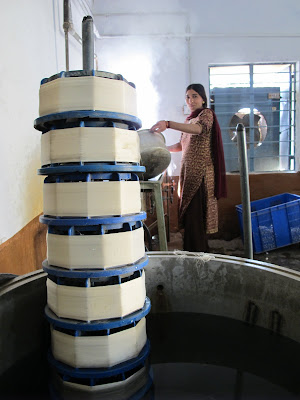Mrs. Sahai runs a government-owned silk factory across the street from the farmhouse. The factory consists of 5-6 small one-storey buildings and produces a variety of of silk threads that range from raw to fine, and hand-spun to machine-spun. She was kind enough to show me around.

The process begins with these

The cocoons are boiled to kill the worm inside
and loosen the threads of silk

Machines twist 2-3 strands of silk into threads

Higher grade, extra strength threads,
are spun from one continuous strand
The assortment
Throughout my tour,
some of the women stared a little, others chuckled at me. I thought it's either
because there was an oriental chick with a fortune cat t-shirt walking around, or
because she was sticking her camera into pots of boiling cacoons. All of them
smiled shyly at me as I "nameste"-ed though their work space.
It was obvious that the number of women staffed at the factory hugely out-numbered the men. Mrs. Sahai informed me that the factory employs roughly 90 workers who are mostly women either living on site, or in nearby communities. The textile industry is one of the most significant sectors of work for woman and is very much apart of the state's heritage.
Being the one of the greenest and most fertile states in India, the land of Mahdya Pradesh
provides a livelihood for many of its poor, who would otherwise be jobless and hungry.




No comments:
Post a Comment